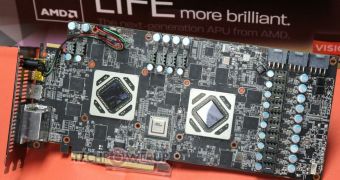Many of our readers are probably wondering where AMD’s dual-GPU answer to Nvidia’s GTX 690 and Tesla K10 is. The answer is that the card was, in fact, ready some time ago, but then AMD decided to redesign it for some reason.
We’ve seen many video card prototypes featuring two of AMD’s Tahiti Radeon HD 7970 GPUs, but the company is not announcing any HD 7990 card and neither are any of its partners that were showing dual-HD 7970 video cards months ago.
The reason is that AMD is now redesigning the power circuit for the cards. They dropped the dual 8-pin connector design for a quad-6-pin connector setup.
There will be four major power lines on the board. One for each of the two Tahiti GPUs, one for the 6 GHz memory, and one for the PLX PCIe Bridge chip.
AMD's famous 6-monitor setup, the Eyefinity6 will reportedly make a comeback using 4 mini-DisplayPort connectors and two DVI ports. AMD, apparently, will not use the “GHz Edition” GPUs, as the chips on the dual-GPU card will likely not be clocked higher than standard HD 7970 GPUs.
Therefore, there’s no Tahiti 2 for the HD 7990.
The graphics processing units are likely to be clocked around 900 MHz and we’re quite disappointed that the finer GHz Edition BIOS is not used.
We would like to see dual-GPU video cards coming with an auto-overclocking feature similar to what modern multi-core processors have.
The driver should practically allow the user to tell the card to overclock one GPU and clock down or even power off the other one if the performance doesn’t scale well when both GPUs are active.
Thus, the card would clock up the GPU closer to the exhaust of the cooling system and power off the other chip or clock it down and use it to accelerate other suitable threads.

 14 DAY TRIAL //
14 DAY TRIAL //